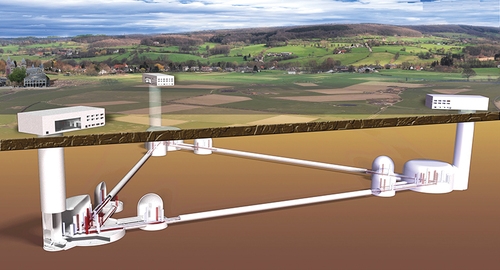Future gravitational-wave detectors aim to probe early universe

The Einstein Telescope, the European vision for a third-generation gravitational-wave detector, would consist of three interferometers formed into a triangle, with 10-kilometer-long arms. To minimize noise, it would be underground and cooled to around 10 K.
PHYSICS TODAY - 01 OCTOBER 2018
Physics Today 71, 10, 25 (2018); https://doi.org/10.1063/PT.3.4041
Toni Feder
The promise of multimessenger astronomy drives the field, brings together scientific communities.
Word traveled fast when gravitational-wave detectors in the US and Europe announced the detection of a binary black hole merger on 14 September 2015. Then on 17 August 2017 the detection of merging neutron stars marked the beginning of multimessenger cosmic science with gravitational waves. (See Physics Today, April 2016, page 14, and December 2017, page 19.) Once that alert went out, dozens of telescopes were pointed toward the merger; radio astronomers are still watching it. Hundreds of papers followed, including one with more than 3500 authors. The excitement created by those detections has the gravitational-wave community chomping at the bit to lay plans for more powerful observatories.
Scientists in Europe put forward a design for the Einstein Telescope in 2011. (See Physics Today, September 2015, page 20.) Their US counterparts held off because NSF, which funded the bulk of the Laser Interferometer Gravitational-Wave Observatory (LIGO), encouraged them to score a detection before focusing on future observatories. So the US Cosmic Explorer design is less far along. But both future facilities would seek to increase sensitivity by at least a factor of 10.
See full text